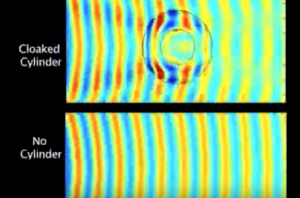Peter Lobner
Metamaterials are a class of material engineered to produce properties that don’t occur naturally.
The first working demonstration of an “invisibility cloak” was achieved in 2006 at the Duke University Pratt School of Engineering using the complex metamaterial-based cloak shown below.
 Source: screenshot from YouTube link below.
Source: screenshot from YouTube link below.
The cloak deflected an incoming microwave beam around an object and reconstituted the wave fronts on the downstream side of the cloak with little distortion. To a downstream observer, the object inside the cloak would be hidden.
 Source: screenshot from YouTube link below.
Source: screenshot from YouTube link below.
You can view a video of this Duke invisibility cloak at the following link:
https://www.youtube.com/watch?v=Ja_fuZyHDuk
In a paper published in the 18 September 2015 issue of Science, researchers at UC Berkley reported creating an ultra-thin, metamaterial-based optical cloak that was successful in concealing a small scale, three-dimensional object. The abstract of this paper, “An ultrathin invisibility skin cloak for visible light”, by Ni et al., is reproduced below.
“Metamaterial-based optical cloaks have thus far used volumetric distribution of the material properties to gradually bend light and thereby obscure the cloaked region. Hence, they are bulky and hard to scale up and, more critically, typical carpet cloaks introduce unnecessary phase shifts in the reflected light, making the cloaks detectable. Here, we demonstrate experimentally an ultrathin invisibility skin cloak wrapped over an object. This skin cloak conceals a three-dimensional arbitrarily shaped object by complete restoration of the phase of the reflected light at 730-nanometer wavelength. The skin cloak comprises a metasurface with distributed phase shifts rerouting light and rendering the object invisible. In contrast to bulky cloaks with volumetric index variation, our device is only 80 nanometer (about one-ninth of the wavelength) thick and potentially scalable for hiding macroscopic objects.”
If you have a subscription to Science, you can read the full paper at the following link:
http://science.sciencemag.org/content/349/6254/1310
Eric Grundhauser writes on the Atlas Obscura website about an interesting quandary for users of an optical invisibility cloak.
“Since your vision is based on the light rays that enter your eyes, if all of these rays were diverted around someone under an invisibility cloak, the effect would be like being covered in a thick blanket. Total darkness.”
So, the Invisible Man is likely to be less of a threat than he appeared in the movies. You should be able to locate him as he stumbles around a room, bumping into everything he can’t see at visible light frequencies. However, he may be able to navigate and sense his adversary at other electromagnetic and/or audio frequencies that are less affected by his particular invisibility cloak.
You can read Eric Grundhauser’s complete article, “The Problem With Invisibility is Blindness,” at the following link:
Recognizing this inconvenient aspect of an invisibility cloak, researchers from Yunnan University, China, have been investigating the concept of a “reciprocal cloak,” which they describe as, “an intriguing metamaterial device, in which a hidden antenna or a sensor can receive electromagnetic radiation from the outside but its presence will not be detected.” One approach is called an “open cloak,” which includes a means to, “open a window on the surface of a cloak, so that exchanging information and matter with the outside can be achieved.”
You can read the complete 2011 paper, “Electromagnetic Reciprocal Cloak with Only Axial Material Parameter Spatially Variant,” by Yang et al., at the following link:
http://www.hindawi.com/journals/ijap/2012/153086/
An all-aspect, broadband (wide range of operational frequencies) invisibility cloak is likely to remain in the realm of fantasy and science fiction. A 10 March 2016 article entitled, “Invisibility cloaks can never hide objects from all observers,” by Lisa Zyga, explains:
“….limitations imposed by special relativity mean that the best invisibility cloaks would only be able to render objects partially transparent because they would suffer from obvious visible distortions due to motion. The result would be less Harry Potter and more like the translucent creatures in the 1987 movie Predator.”
You can read the complete article at the following link:
http://phys.org/news/2016-03-invisibility-cloaks.html
Further complications are encountered when applying an invisibility cloak to a very high-speed vessel. A 28 January 2016 article, also by Lisa Zyga, explains:
“When the cloak is moving at high speeds with respect to an observer, relativistic effects shift the frequency of the light arriving at the cloak so that the light is no longer at the operational frequency. In addition, the light emerging from the cloak undergoes a change in direction that produces a further frequency shift, causing further image distortions for a stationary observer watching the cloak zoom by.”
You can read the complete article, “Fast-moving invisibility cloaks become visible,” at the following link:
http://phys.org/news/2016-01-fast-moving-invisibility-cloaks-visible.html
So, there you have it! The Invisible Man may be blind, the Predator’s cloak seems credible even when he’s moving, and a really fast-moving cloaked Klingon battlecruiser is vulnerable to detection.